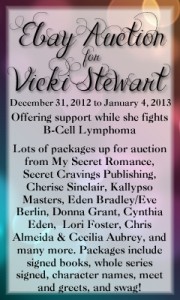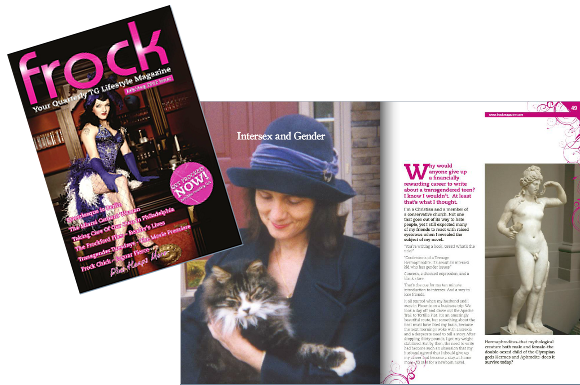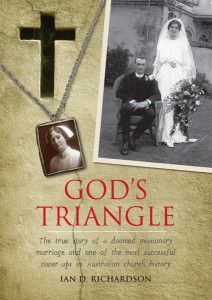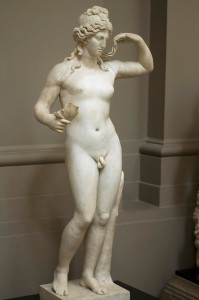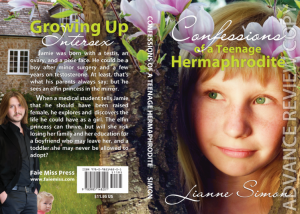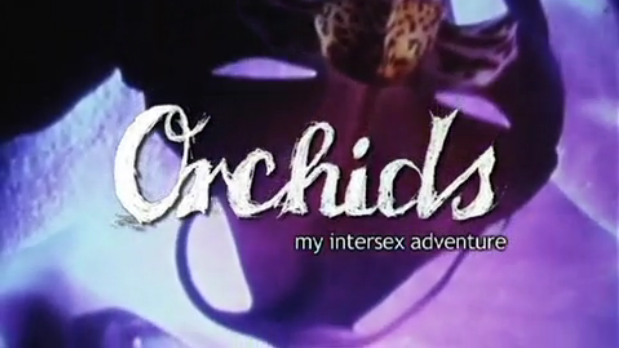This giveaway is associated with the Heroines With Heart book tour. My book is one of those being featured in January.
I Write Like
I Write Like is software that analyzes an author’s writing. I found the results to be mildly amusing.
Charity Auction!
An Intersex Primer
Hermaphroditus–that mythological creature both male and female–the double-sexed child of the Olympian gods Hermes and Aphrodite–does it survive today?
Human sexual development is a complex process involving differentiation into male and female, from fetus to adult. The process can be misdirected genetically, or break down along the way, resulting in a reproductive system that remains unfinished. Intersex is a blanket term for the various conditions resulting in these differences.
Actually, DSD–Disorder of Sexual Development–is the term some prefer, intersex/intersexed being somewhat politically incorrect, and hermaphrodite so often misunderstood.
Although the markers of sex–genetics, gonads, genitals, etc.–aren’t all on the male side or the female side, in intersex the choice of gender isn’t an issue as often as one might think.
Complete Androgen Insensitivity Syndrome (CAIS) leaves the body unable to process male hormones. An XY conception becomes a female child with testes in her abdomen and no ovaries or uterus. The testes don’t produce sperm, but some of the testosterone is converted into estrogen, which gives the child a feminine puberty.
Swyer Syndrome or Pure Gonadal Dysgenesis is a condition in which the testes don’t form; the result is an XY female with a uterus but no ovaries.
Turner Syndrome results from the loss of the second sex chromosome. Turner babies are female, but their ovaries are only streaks of tissue. Because the sex chromosomes help determine height, Turner Syndrome women are short-statured, averaging something like four-foot-eight as adults.
Klinefelter’s(XXY) and Kallman’s are two intersex conditions affecting men. They don’t ordinarily result in genital ambiguity. Because of the extra sex chromosome, the average adult height in Klinefelter’s is greater than in XY.
None of these intersex conditions result in the mythological hermaphrodite, at least not in the sense of having both sex organs. When intersex affects the genitals, they turn out somewhere between male and female. The Quigley Scale describes the range of intersex genital shapes.
Partial Androgen Insensitivity Syndrome(PAIS) results in ambiguous genitals, and breast development at puberty. The severity varies depending on which genetic mutation is responsible.
Congenital Adrenal Hyperplasia can result in masculine genital development in an XX baby, sometimes enough so that the child is raised male. Although CAH can be fatal if not treated, most CAH girls can bear children. One possible complication in CAH children being raised as boys is a feminizing puberty.
A 5-Alpha Reductase deficiency in an XY baby results in feminine genitals, but masculine development at puberty. 5-Alpha children, although sometimes castrated by their doctors and raised as girls, can be fertile males.
Mixed Gonadal Dysgenesis is a partial form of Turner Syndrome. Some cells have a Y chromosome; some don’t. The distribution of the cells during fetal development determines how the gonads develop and how tall the child will grow.
The medical definition of hermaphroditism is having both testicular and ovarian tissue. In Mixed Gonadal Dysgenesis, the child may be born with one testis and one streak ovary. Or they may have two ovatestes. Streak ovaries are non-functional and mixed gonadal tissue often results in cancer.
When a child is born with ambiguous genitals, parents and physicians must decide whether the child should be raised as a girl or a boy. Most experts recommend that a gender be chosen for the baby, but cosmetic surgeries be put off until the child can participate in treatment decisions. Until then, it’s important for parents to preserve their child’s options.
With or without surgical intervention, some children reject the gender assigned them. Determining when a gender change is appropriate may be difficult. Children aren’t always willing to verbalize their feelings and may not be aware of their options.
2012 AIS-DSD Meeting–Jeanne Nollman
Message from Jeanne Nollman
President
AIS-DSD Support Group for Women & Families
Impressions of our annual conference–Finding self and embracing community
Our 2012 annual conference in Oklahoma City was a wild success. The temperatures were fairly mild, and the hotel was very welcoming. We had about 125 registered participants. A third were DSD women/children, another third family members/parents, and the remaining third comprised of medical professionals and allies. Many in attendance were first timers. Our attendees came from all over the United States, and as far as Italy, Brazil, U.K., and from Canada.
Arlene Baratz, mother of two AIS women, medical advisor, and co-moderator of the parent group, hosted a spectacular conference. There was a diverse mixture of seminars/workshops that provided information and support to all of our attendees. Subjects covered this year included: mental health, advocacy, DSD 101, informed consent, infertility, adoption, PTSD, and disclosure. A considerable amount of time was set aside for participants to be able to share their stories. We also had a special Congenital Adrenal Hyperplasia (CAH) track this year. We are eager to develop programming and opportunities for participation in this critically underserved community.
Seminars/workshops were geared towards DSD teens, adults, and parents/families. Childcare was provided for the little ones. Seminars/workshops were lead by physicians, psychologists, social workers, lawyers, and DSD leaders in the community. The keynote address by Bo Laurent was riveting. She gave us a personal account of the birth of intersex awareness and how intersex/DSD advocacy has evolved.
Thank you!
This year we did not have a silent auction but instead raffled off donated items. The raffle was a huge financial success and a whole lot of fun! Thank you to everyone that brought or sent something for the raffle. A big thank-you to all our volunteers and raffle ticket sellers. Proceeds help fund scholarships to those in need who would otherwise be unable to attend the conference. Big thanks also to all who made donations to AIS-DSD. These donations fund scholarships and pay for services that keep the organization running smoothly.
Continuing Medical Education
This year we had a great showing (approx. 65) of medical professionals at our third annual one-day medical conference. Participation is growing every year and we have high hopes that projects will spring forth as a result of some brainstorming sessions to look at improving standards of care for individuals and families impacted by Disorders of Sex Development.
Concurrent track for males with DSDs planned for 2013
As some of you may know, an online men’s DSD support group was formed this year. It currently has a handful of men involved. At the conference we had several male children with a DSDs in attendance. The board has approved a male DSD track to run concurrently with our conference in 2013. We feel this is a “best practices” move to service our male children who will soon be adults.
Plan now to join us in Boston next summer.
We are excited to announce that our next annual conference will be in Boston, Massachusetts. Tentative plans are underway for future conferences in San Francisco (2014) and Cincinnati (2015). When planning future conferences, we look at finding a medical facility that has a DSD team, affordable airline fares, and a hotel that can accommodate our needs.
We’re here for you.
To become involved in our email circles and private social media for affected adults, parents, teens and emerging adults, write us at AISDSD AT HOTMAIL DOT COM and be sure to check in at WWW.AISDSD.ORG for more info and the latest news on conference planning.
President-Jeanne Nollman
Frock Magazine Article
One of the things I love about MuseItUp Publishing is their editors. They’re some of the best in the industry, and are also committed to seeing their authors succeed. So it was no surprise when my content editor, Tanja Cilia, approached me about writing something for an online magazine.
Frock Magazine caters to the transgender community. I have to confess that my first thought was that if I were to write something for them, I’d get grief from both my intersex friends and my Christian friends. So, at least for a while, Tanja was more enthusiastic than I was.
Confessions of a Teenage Hermaphrodite is the coming of age story of a teen who was born with one testis and one ovary. In Jamie’s case, the sex-of-rearing decision was fairly arbitrary. The main theme of the book is Jamie’s struggles to fit in as one gender or the other. The story is set in the early 1970s, a time when most people still thought of gender strictly in terms of boy or girl.
My first impression of Frock Magazine was its outstanding production quality. Definitely first rate. After corresponding with Katie Glover, Frock’s friendly editor, I agreed to come up with something a bit lighter and less technical than what I’d ordinarily write. I hope you’ll hop on over to their site and read it.
To my friends who may object–One reason I wrote Confessions was my concern for intersex children who struggle to find their place in this world. Sometimes gender issues are a result of a disorder of sex differentiation (DSD). Sometimes they’re a result of inappropriate DSD treatment. In any case, the real question is how to help them. The readers of Frock Magazine are likely to at least have some understanding of and sympathy for the gender issues these children encounter.
Intersex and Gender Article
or you may subscribe to Frock here.
Ian Richardson – God’s Triangle
Today’s interview is with Ian Richardson, the author of God’s Triangle. Thank you so much for agreeing to do an interview, Ian.
How long have you been writing?
I have always loved writing. My first “professional” writing was in my early teenage years when I would earn a dollar a time writing to magazines with Letters to the Editor. When I turned 16, I had to leave school to help my father, who was dying, with his rural newspaper in Australia. He let me write some of the news items and that was the real beginning to my career.
What do you like the most and least about the craft?
I like everything about writing.
What genre do you generally write?
Having worked for more than 25 years as a journalist for the British Broadcasting Corporation (BBC) in London, I have learned to turn my hand to anything. In recent years I have concentrated on screenwriting. God’s Triangle is my first book.
Tell me about God’s Triangle. How did it start? At what point did family history become a book?
The story of God’s Triangle began in 1997 during a visit to Australia to see my mother. We were sifting through old family photographs and I spotted a tallish woman I had never seen before. My mother evasively dismissed her as “just Aunty Florrie Cox”. She added: “The family didn’t talk about Florrie”. She couldn’t tell me why, except that Florrie had been a missionary in India and that her marriage to another missionary had failed because of an affair her husband had with a third missionary.
My curiosity was excited, but initially my enquiries were simply to fill in a gap in the Cox family history. As more and more information was revealed over the years, I felt it would make an excellent feature film. An Australian movie producer agreed. It was then that I came up with the name God’s Triangle because the three main characters were committed Christians.
My wife and assistant researcher, Rosemary, felt I needed to assemble a detailed historical record of what had been discovered. From that emerged the book.
Your aunt had an unusual medical condition. How did you discover what it was? What did you think when you first became aware of it? Did you do any research?
When Rosemary and I began the research, we had no idea what we might find. All we had for several years was the assertion by the son of my great aunt’s ex-husband that the marriage had broken down “because your aunt never told my father she couldn’t have babies”.
The first real clue to Florrie Cox’s condition was revealed when I won an 18-month battle with the Supreme Court of Victoria, Australia, to gain access to the divorce records which had been marked “closed for all time”. A medical specialist in London read the file and was able to identify her precise condition.
How much did your aunt know? Does her condition play a pivotal role in her marriage problems?
My aunt never knew what was wrong with her, except in the most general terms. She grew up in a very religious Protestant family in an age when sex was a totally taboo subject.
It was also a time when unmarried couples were not allowed on “dates” without a chaperone to ensure that they didn’t exchange anything more than a hug or a chaste kiss or two.
The first Florrie knew that something was wrong was on her honeymoon when she and her husband, the Reverend Frank E. Paice, discovered they were unable to have intercourse. The marriage never recovered from that.
Florrie went to her grave in 1950 thinking she was some form of freak, getting little support from her embarrassed family or from the equally-embarrassed Baptist Church in Australia. Her actual condition was not given a name until after she died.
What will the reader learn about intersex from your book?
A lot, I would hope. Above all, understanding and tolerance. Sympathy, too, but not pity.
The promotion of God’s Triangle for the general public has deliberately avoided revealing that Florrie Cox had a very rare intersex condition. There are two chief reasons: it is a true-life detective story and it would be unfair for the general reader to know about Florrie’s condition at the outset. More importantly, I wished to avoid her being pre-judged. I wanted to lead readers along that same path that I took so that they would develop the same understanding that I had.
Without wishing to appear pompous, I feel that God’s Triangle – both the book and ultimately the film – will result in intersex in all its variations being viewed as just a part of mainstream society, rather than a condition to be regarded with suspicion.
I spent a year in Asia on a missions trip, but I’m sure it was much different from missions during the time covered in your book. Tell us a little about that if you would.
Yes, things have certainly changed since my great aunt was a missionary. Back then, they believed they had a God-given right to attempt to convert the entire non-Christian world to Christianity, regardless of the consequences for themselves or their converts. They were well-intentioned but very misguided, in my view.
My view is that “doing good” should not be tied to a conviction that the recipients should respond by “taking Jesus into their hearts”. Most Christian aid workers these days are what I call “Christians by example”, rather than evangelists. They help those who need help, but expect nothing in return but a few words of thanks and the satisfaction of knowing they have contributed to the betterment of global society.
How can someone purchase your book in the US?
God’s Triangle can be purchased online through http://godstriangle.com/. The British price converts to about $US17.50 at the current exchange rate. Delivery to US addresses usually takes less than two weeks.
The ebook is also available on Kindle through Amazon:
http://www.amazon.com/dp/B0085XM9IK
What are you currently working on?
Making sure God’s Triangle is a success and that the film version gets made as soon as possible.
What do you do for fun and relaxation when not writing?
Family things, swimming, trying to put the world right and gossiping with my journalist mates.
Which authors do you like to read?
I love Bill Bryson.
Do you have any tips for aspiring authors?
Yes. Keep at it, but don’t be precious about your work. No matter how wonderful your writing is, a good editor will always improve it.
Is there anything else you’d like us to know about you?
I have told my producer in Australia that I will refuse to die until I see the film version of God’s Triangle on the screen!
Thank you!
An Intersex Primer
Hermaphroditus–that mythological creature both male and female–the double-sexed child of the Olympian gods Hermes and Aphrodite–does it survive today?
Human sexual development is a complex process involving differentiation into male and female, from fetus to adult. The process can be misdirected genetically, or break down along the way, resulting in a reproductive system that remains unfinished. Intersex is a blanket term for the various conditions resulting in these differences.
Actually, DSD–Disorder of Sexual Development–is the term some prefer, intersex/intersexed being somewhat politically incorrect, and hermaphrodite so often misunderstood.
Although the markers of sex–genetics, gonads, genitals, etc.–aren’t all on the male side or the female side, in intersex the choice of gender isn’t an issue as often as one might think.
Complete Androgen Insensitivity Syndrome (CAIS) leaves the body unable to process male hormones. An XY conception becomes a female child with testes in her abdomen and no ovaries or uterus. The testes don’t produce sperm, but some of the testosterone is converted into estrogen, which gives the child a feminine puberty.
Swyer Syndrome or Pure Gonadal Dysgenesis is a condition in which the testes don’t form; the result is an XY female with a uterus but no ovaries.
Turner Syndrome results from the loss of the second sex chromosome. Turner babies are female, but their ovaries are only streaks of tissue. Because the sex chromosomes help determine height, Turner Syndrome women are short-statured, averaging something like four-foot-eight as adults.
Klinefelter’s(XXY) and Kallman’s are two intersex conditions affecting men. They don’t ordinarily result in genital ambiguity. Because of the extra sex chromosome, the average adult height in Klinefelter’s is greater than in XY.
None of these intersex conditions result in the mythological hermaphrodite, at least not in the sense of having both sex organs. When intersex affects the genitals, they turn out somewhere between male and female. The Quigley Scale describes the range of intersex genital shapes.
Partial Androgen Insensitivity Syndrome(PAIS) results in ambiguous genitals, and breast development at puberty. The severity varies depending on which genetic mutation is responsible.
Congenital Adrenal Hyperplasia can result in masculine genital development in an XX baby, sometimes enough so that the child is raised male. Although CAH can be fatal if not treated, most CAH girls can bear children. One possible complication in CAH children being raised as boys is a feminizing puberty.
A 5-Alpha Reductase deficiency in an XY baby results in feminine genitals, but masculine development at puberty. 5-Alpha children, although sometimes castrated by their doctors and raised as girls, can be fertile males.
Mixed Gonadal Dysgenesis is a partial form of Turner Syndrome. Some cells have a Y chromosome; some don’t. The distribution of the cells during fetal development determines how the gonads develop and how tall the child will grow.
The medical definition of hermaphroditism is having both testicular and ovarian tissue. In Mixed Gonadal Dysgenesis, the child may be born with one testis and one streak ovary. Or they may have two ovatestes. Streak ovaries are non-functional and mixed gonadal tissue often results in cancer.
When a child is born with ambiguous genitals, parents and physicians must decide whether the child should be raised as a girl or a boy. Most experts recommend that a gender be chosen for the baby, but cosmetic surgeries be put off until the child can participate in treatment decisions. Until then, it’s important for parents to preserve their child’s options.
With or without surgical intervention, some children reject the gender assigned them. Determining when a gender change is appropriate may be difficult. Children aren’t always willing to verbalize their feelings and may not be aware of their options.
Advance Review Copies
Why is it that you always find another error just after you send off the manuscript? A glaring, in-your-face-something that you messed up? I guess that’s what proofs are for. At least this time it was only two minor formatting issues.
I had used LibreOffice(OpenOffice successor) to generate my manuscript PDF, with embedded fonts and all. I used Gimp to do the cover artwork, but eventually found a copy of PhotoShop I could afford. It’s better at converting to CMYK than anything else I’d tried.
Uploading the internal document and cover artwork went without a hitch. In a few days, my printer sent me a proof. The ARCs (advance review copy) should arrive shortly.
I continue to work with my e-book publisher on line and copy editing. We’re still planning a September release of Confessions of a Teenage Hermaphrodite. Meanwhile, I’m sending out advance copies to anyone I can find who does reviews.
Phoebe Hart – Orchids: my intersex adventure
Phoebe Hart is a documentary filmmaker. Orchids: My Intersex Adventure presents her story of self-discovery. Thank you so much for being here, Phoebe. Would you tell us a little about yourself?
I’m Phoebe Hart. I am a documentary filmmaker and CAIS woman based in Brisbane Australia
How and when were you told your diagnosis?
My mother told me I didn’t have a womb and couldn’t menstruate or get pregnant when I was about 11. She then filled in all the gaps when I was about 17 and I’ve been researching it ever since!
Can you explain a little about your condition?
CAIS is a congenital condition whereby I have 46XY chromosomes and testes but androgens such as testosterone have no effect on my body so I developed as feminine in the uterus.
What do you like the most and the least about having a difference of sexual development?
I don’t like being different. But, at the same time, it’s pretty cool (being different).
Making a movie is a pretty bold move. How has the publicity affected you and your family?
The movie I made – Orchids: My Intersex Adventure – was therapeutic but in the way that shock therapy is therapeutic. It was something that created waves but in the end has helped my family come together. It was something I had to get off my chest and, not really by choice, I had to drag everyone I love along with me. Otherwise, I was surprised how few people recognized me after it was broadcast in Australia!! (Phew!)
How has your condition affected your relationships?
Not really. I’m married now and, after quite some years of marriage, my husband did grieve not having the opportunity to have his own biological children. But you never know what life has planned and he may get his wish yet.
Has it affected your religious views? How have Christians treated you?
I was raised to be a leftwing atheist. If anything, nowadays I have an Eastern religious perspective along the lines of Buddhism. I have some views about intersex and spirituality along the lines of “two spirit” beings. However, I’ve never had any bad reactions from other religions including Christianity. In fact, the church-going people I tell about my CAIS generally congratulate me on my courage, and then tell me about the godly virtues of adoption, etc. It might be easier for religious people to accept AIS as it’s “god’s choice” and part of the glory of his/her creation rather than an individual wandering off the righteous path.
Have you ever thought about who you might have been without your condition?
I would be a boy, yes. I would have probably really loved that. But, it’s my destiny to live in this body, and perhaps my kharma – what I needed to learn in this lifetime.
Is there something you’d like to share that might surprise people?
My movie is going to show on the TV in America – on Showtime.
What’s the one thing you’d most like people to know about you?
I’m a nice person, but I’m not perfect. Far from it. However, I believe there’s a power to telling our stories and that should be celebrated.
Thanks for sharing. More information on the film may be found the website or on Facebook


